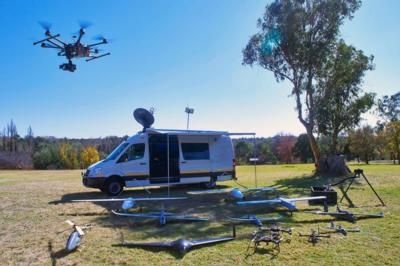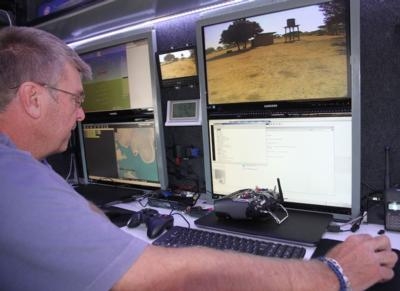Company Working With Government To Help Stop Illegal Killing Of Animals
In South Africa’s National Park, a team of park rangers, anti-poaching officials and UAV pilots are working to stop the illegal harvesting of Rhinos for their horns.

Recently in a command and control center- a technology stacked RV, with monitors, detection instruments and two-way radios tracked a group of rhinos in the African bush, and their slow movement were broadcast on the team’s monitors in real time. Earlier that day, park rangers were tipped off about a group of poachers who were planning to infiltrate the grounds overnight to illegally slaughter rhinos for their horns.
The park rangers, anti-poaching officials and UAV pilots have refined the collaborative anti-poaching process: they park the monitoring vehicle, set up the technology in less than ten minutes, and deploy a UAV to patrol the expansive grounds. Two stations, a sensor operator station and a flight operator station, are equipped with video monitors and control equipment.
Anti-poaching units and section rangers work with the UAV operators to compare incoming data with their local knowledge of the terrain. If any poachers are detected in the area, the team deploys an anti-poaching group that results in their arrest, and ultimately saves the threatened animals.
“We are the operators responsible for deploying the UAVs in the bush, and interpreting the incoming information for the people who need it,” said Rob Hannaford, founder of one of the first South African organizations to build, design and develop UAVs. “Our UAVs are equipped with thermal imaging hi-res cameras that locate illegal poachers in the darkness from a great distance away.”
“We are the operators responsible for deploying the UAVs in the bush, and interpreting the incoming information for the people who need it,” said Rob Hannaford, UVU graduate and one of the first South African organizations to build, design and develop UAVs. “Our UAVs are equipped with thermal imaging hi-res cameras that locate illegal poachers in the darkness from a great distance away.”

Hannaford’s business tackles a problem never before addressed with UAV technology: monitoring threatened animals, without individual trackers, in real time. According to Hannaford, unmanned aerial vehicles (drones) are the most efficient and successful tools for surveying sprawling grounds. UAVs provide instantaneous footage, while also remaining undetected and does not disturb the animals as a helicopter or plane would. UAVs are equipped with hi-res thermal imaging cameras, long-range video feed capabilities, and object detection software. They are tough enough to withstand harsh elements in the African bush, and they’re cheap to repair if need be. All of these qualities, says Hannaford, are what makes a UAV the ideal method to monitor the park’s grounds.
“The solution is durable, cheap, and extremely efficient,” Hannaford (pictured) said. “Plus, ninety-five percent of the poaching incidents happen at night, which is why thermal imaging cameras are absolutely critical to this process. We are able to determine where the animals and the poachers are located based solely on the infrared heat they emit.”
In South Africa, the fight against rhino poaching is commonly referred to as a war. Their government takes the protection of these animals with the utmost seriousness, but the slaughter is still increasing. According to Hannaford, myths surrounding the supernatural powers of rhino horns run rampant in Chinese and Vietnamese villages, spawning groups to infiltrate designated reserve areas in pursuit of the revered goods. “One rhino is shot every eight hours,” he said grimly. “We need to utilize cutting-edge technology to stop this rhino war that’s being waged on our land.”
But UAVs offer unprecedented technology that has never before been introduced. Government officials across Africa are reaching out to Hannaford to find out what technology he’s using.
In conjunction with the local authorities and anti-poaching groups, UDS has successfully flown over 1,500 anti-poaching missions. Hannaford is also developing unmanned aerial vehicles for South Africa’s commercial industry, with specific solutions designed for 3D mapping, photography, precision agriculture and beyond.
(Images provided by Unmanned Vehicle University)
 Airborne 11.24.25: ANN's 30th!, Starships V3 Booster Boom, Earhart Records
Airborne 11.24.25: ANN's 30th!, Starships V3 Booster Boom, Earhart Records ANN FAQ: Submit a News Story!
ANN FAQ: Submit a News Story! Classic Aero-TV: DeltaHawk Aero Engine Defies Convention
Classic Aero-TV: DeltaHawk Aero Engine Defies Convention NTSB Final Report: Glasair GlaStar
NTSB Final Report: Glasair GlaStar ANN's Daily Aero-Term (11.22.25): Remote Communications Outlet (RCO)
ANN's Daily Aero-Term (11.22.25): Remote Communications Outlet (RCO)




